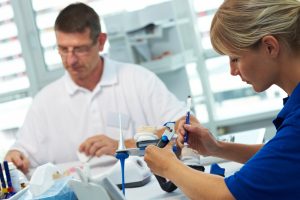BLOG

Dental Attachment Considerations
Given the different types of dental attachments available, dentists need to consider various factors when selecting a denture for the job. Each attachment comes in a variety of models and, afterward, there are more considerations to focus on. Clips and bars, studs, magnets, and telescopic copings each bring different options to the table and each model can remedy a unique situation.
Hence, the team at Ocean Ceramics would like to inform you of the different considerations used to select dental attachments.
Patient’s Dental Status

An examination of the patient’s unique condition will begin to inform the choice of dental attachments. This usually begins with a Cone-Beam Computed Tomography (CBCT) scan. This particular scan produces 3D images of a patient’s teeth, gums, nerves, and jaws and allows the dentist to identify their particular needs.
The bone quality in the patient’s jaws also serves as a determining factor. Bone density in the mandible (lower jaw) is usually more than that of the maxillae (upper jaw). This allows dentists to use studs more often in the mandible and choose bars more often for the maxillae.
Attachment Resilience
Each dental attachment has a different level of resiliency, the amount of movement allowed between the prosthesis and the support structures. When the prosthesis can move directionally, there is less stress on the implant, hence it is resilient. However, an attachment with less resilience is suitable in certain situations.
Rigid attachments allow no movement, putting all the force from any movement on the implant. This attachment is mostly used when there is a sufficient amount of implants available. An example of this particular attachment is a screw-retained hybrid overdenture.
Restricted vertical resilient attachments allow for vertical movement in the prosthesis without any lateral, rotary, or tipping motions. The relief provided to the implant however is minimal, about 5% – 10%.
Hinge-resilient attachments prevent any forces that cause skidding, tipping, and rotational movement. These dental attachments relieve approximately a third of the load on the implant, transferring it to the attachment itself and parts of the residual ridge of the mouth. Any round bar like the Hader bar provides hinge resilience.
Combination resilient attachments provide unrestricted movements in vertical and hinge planes. The vertical motion forces are transferred to the residual ridge, as such tissue support of the prosthesis is increased to compensate. This type of dental attachment reduces the load on the implant by half approximately.
Rotary resilient attachments facilitate movement in vertical, rotation, and hinge planes. This is used to allow the prosthesis to move around the sagittal plane, reducing the load on the implant by almost three-fourths. Stud attachments have been shown to provide rotary resilience.
Universal resilient attachments allow for movement in all directions except away from the supporting tissue. The load on the implant is minimal. The best example of this type of dental attachment is the magnetic attachment
Ease of Use

The ability of a patient to independently service the denture also comes into play. After receiving a dental attachment, the patient is the primary caregiver of the attachment. The ease of cleaning or servicing the denture makes a significant difference.
A rigid overdenture bar is especially useful in a situation like this. If a fixed detachable requires fixing and cleaning, the entire attachment has to be removed as well. That includes the composite, Teflon tape, and the screws holding the prosthesis in place. An overdenture bar can be easily removed by a patient for any servicing and cleaning.
Ocean Ceramics – Vancouver’s Premium Dental Laboratory
The considerations for dental attachments open up a variety of options to solve a patient’s problem. Getting it right is an involved but key process that will ensure that the patient’s dental health is not compromised.
Please contact us for your dental prosthetics. Ocean Ceramics has been creating the highest-quality dental attachments and implants for over 45 years. Our commitment to staying on the cutting edge of dental technology and our strong team have fostered our growth. We are committed to ensuring your dental needs are never left wanting.
TAGS
ABOUT US
Ocean Ceramics is a
dental lab in Vancouver,
BC that educates and delivers full and partial mouth reconstruction, including implants, crowns and prosthetics.
CONTACT US
Ocean Ceramics Ltd.
#1-3180 262nd Street
Aldergrove, BC
V4W 2Z6
1(604) - 777 - 1337
OUR FAMILY
Ocean Ceramics
Denta4
Trio
